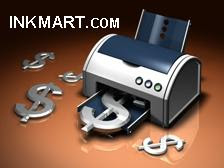
Did you ever notice that whenever you purchase a new printer, you’re excited to have it, and the printer does a beautiful job? You find yourself printing up all the pictures you’ve ever taken, stored or received in your e-mails.
It seems like only a few days before your ink cartridges are empty in your new printer. So you mosey on down to the local office supply to restock your ink cartridges. You pick yourself up off the floor when you see the price of the new brand name cartridges. Then your eye is drawn to the new printer in the opposite aisle, and guess what? It’s on sale cheaper than it would cost to buy new cartridges!
You want to use excellent, dependable ink and toner cartridges in your printer, and you want to save money. Printing costs money, and the cost of doing business today is greater than ever. So do you opt to pay more for new OEM cartridges by ordering them from the printer manufacturer, or do you pay less for Remanufactured cartridges or Compatible cartridges, which will save you tons of money and make you more ecofriendly, since they recycled?
And you ask yourself - are Remanufactured and Compatible cartridges as dependable? What is the difference? And will you take a chance on voiding your printer’s warranty if you use them instead of new ones?
First, you need to understand the differences between OEM, Remanufactured and Compatible ink and toner cartridges.
OEM Cartridges
The standard brands of ink and toner cartridges that you buy at an office supply store, such as Office Depot or Staples, or from an online ink and toner vendor, such as InkMart.com, are known as “original equipment manufacturer” (OEM) cartridges. These cartridges are made by the original manufacturer of the printer. OEMs are much more expensive than remanufactured or compatible cartridges. You can buy them from online retailers, such as InkMart.com much more cheaply than from the printer manufacturer or your local office supply store and save as much as 20% to 70%, however. Many businesses, at the behest and to the financial benefit of those manufacturers, believe that buying OEMs is the only way to go. However, you may be surprised at the facts regarding the alternative options.
Remanufactured Cartridges
Remanufactured cartridges are typically made from the exact same parts that OEM cartridges are. People return their used cartridges to be recycled. Remanufacturers then thoroughly sanitize the cartridge print heads, components, etc. (in the case of a toner cartridge they thoroughly inspect the drum). Then the cartridges are refilled with premium ink or toner. Lastly, a testing stage involving pressure and an actual printing run is performed to make sure each cartridge is working properly, and the cartridge is repackaged and ready for use. Remanufacturers can be ISO certified facilities, and such vendors as InkMart only deal with these companies, so that they can give an ironclad 100% guarantee of these products.
However, there are some ink and toner suppliers that claim their cartridges are remanufactured, but they are simply refilled with toner or ink (this is common at some national ink and toner storefront retailers). This practice is known as “drill and fill,” and consumers experience many more cartridge failures using these aftermarket products. This is something to be wary of, and customers should ask these retailers where they get the cartridges and see a sample to evaluate how the cartridges are handled and filled.
Compatible Cartridges
Compatible toner cartridges (sometimes called re-engineered cartridges) are effectively the generic counterpart of OEM cartridges. These cartridges are manufactured using almost all new components. In some cases, the original plastic container is used, but all moving and operational components are new. They follow a manufacturing process very similar to the OEM process, and are tested for quality assurance.
Some suppliers use factories that are not certified, but a few, such as InkMart, carry compatible toners manufactured only in ISO9001 and ISO14001 factories, meaning that their required standards are exactly the same as the OEM cartridge manufacturers. It is important to note that there can be a very wide range of quality in ink and toner cartridges. That is why it is important to recognize that these Compatible cartridges are manufactured in ISO registered facilities to guarantee quality.
Cartridge Standards
The International Organization for Standardization, or ISO, sets quality standards for various manufacturing processes. The ISO standard is comprehensive and touches on each aspect of the supply chain from raw source materials all the way to end-user delivery. While product defects are occasionally inevitable, the goal of ISO is continued improvement to limit any problems and constant work to improve the quality of outputs. Buying an ISO-certified ink cartridge helps ensure that, while you are saving on your ink refills, you are not sacrificing quality standards.
The Remanufacturing Process
To better understand the way Remanufactured and Compatible cartridges are made, note the following:
1. Incoming cartridge is disassembled and components are inspected.
-- The waste bin assembly is completely dismantled removing every spring,
screw, bracket and component for inspection.
-- The hopper assembly is completely dismantled removing every spring
screw, mag sleeve and doctor blade for inspection.
2. Toner is removed and internal/external parts are cleaned.
-- The toner hopper is cleaned internally to remove all residue toner from the
previous use, preventing old, clumped toner from contaminating the new toner.
-- Sweeper blades located within the hopper are inspected and replaced if necessary.
-- The waste bin assembly is emptied and cleaned.
-- Sweeper blades within the waste bin are inspected and replaced if necessary.
-- The surface of both the waste bin and hopper sections of the cartridge are cleaned.
3. Worn components are replaced with “new” premium parts.
-- A new long-life (5 cycle) photoconductor drum and wiper blade is installed in the
waste bin assembly.
-- Recoated primary charge rollers (if applicable) are installed in the waste bin
assembly.
-- All other non-wearing components (i.e. transfer roller, developer roller and
assembly hardware) are cleaned/inspected and replaced if necessary.
4. Cartridge is refilled and reassembled.
-- New premium toner of OEM type and gram weight (or higher weight) is poured
into the hopper assembly.
-- A new mag sleeve and doctor blade is installed to the hopper assembly.
-- Hopper assembly checked for leaks.
5. Cartridge is post-tested for print and visual quality.
-- Every cartridge produced is tested in its proper machine.
-- A minimum of 10 test pages are run to determine quality.
6. The cartridges are then packed for shipment.
-- Each cartridge is sealed in anti-static foil bag.
-- Each cartridge is bubble wrapped and placed in a compatible carton denoting
the type of cartridge and printers that use same type cartridge.
-- The cartons are sealed and shipped to the supplier from which you buy your ink and toner.
This process ensures that you will receive a quality Compatible cartridge, and ISO-certified manufacturers follow these guidelines.
Understanding the differences between the types of new and used ink and toner cartridges and how they are made by an ISO-certified manufacturer, as opposed to someone sitting in the back of his van or at his office and simply drilling a whole and filling the cartridge with toner, is invaluable when purchasing quality cartridges at the lowest price, thus keeping your costs down. They have no way to test the components to see if they are working properly, or check all the parts or the jets, or otherwise ascertain whether ink or toner they are filling cartridges with is clear and clean. Spending less money to purchase substandard, non-certified cartridges is simply a waste of your money.
Magnuson-Moss Warranty Act
One of the oldest excuses manufacturers have used in the past to deter customers from using Compatible or Remanufactured supplies is that doing so would void the warranty of the printer. Years ago, the U.S. Government instituted the Magnuson-Moss Warranty Act (the “Act”), which in effect prevents any manufacturer from voiding the warranty of any device simply based on the use of compatible or remanufactured parts or supplies.
The more knowledgeable you are about who makes ink and toner cartridges, how new OEMs differ from Remanufactured and Compatible cartridges, and what myths are out there about voiding warranties, the better prepared you are to pick a great supplier to keep your printers working great!
Additional Note from the Author:
An additional note: InkMart.com is a direct importer/supplier, not a manufacturer, of only quality brands of compatible cartridges, and InkMart’s ISO certified manufacturers have all guaranteed the quality of their cartridges to InkMart. This allows InkMart, as the supplier, to offer its ironclad 100% Warranty that, should any Compatible or Remanufactured product InkMart sells cause harm to a customer’s printer, copier or fax machine, InkMart will be responsible for cleaning and repairing or replacing the equipment upon proof from a certified technician. Their support of their products is second to none, and for any customer, there is no risk whatsoever in using InkMart.com products, so consumers get all the savings and benefits and none of the risks. Copyright 2010 InkMart.com


